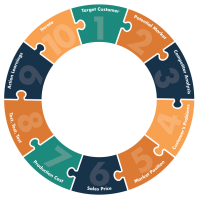Do you know what your competitive advantage is?

Recently, I heard a great example highlighting how vast the gulf can be between what a business thinks its competitive advantage is, and what it actually is in the customers’ eyes.
A local take-away restaurant prided itself on the quality of its ingredients and the authenticity of its food. To them, the quality of the food was why customers keep returning to them. Yet in a customer survey, they discovered that the key factor that brought customers back was the price, it was cheaper than the chain take-away down the road.
To discover that your customers are coming to you because you’re the cheapest option and NOT because of the delicious authentic food you serve is quite a blow on two fronts, firstly, the chef’s ego may need some soothing, and secondly, the whole premise behind the business brand, positioning and marketing is flawed.
Find your competitive advantage
It is absolutely critical for every business to know what its competitive advantage is in the market place – why customers come to them rather than a competitor.
Promoting a product based on its quality is not going to have an impact if the customers are only interested in price.
If management thought their loyal customers were devoted to the delicious food that only they served, they would have a rude shock when all of their price-sensitive customers deserted them overnight for a different take-away following a price rise.
Discovering you are playing in a price-sensitive field, rather than a quality driven one raises so many questions about your business:
- How much does the food quality matter? If you switched from Italian buffalo mozzarella to a lower value mozzarella, would that actually drive your customers away?
- What is the critical price point you need to keep your customers? How high can you go before losing market share? What portion of your customers are price orientated, and what portion are quality-orientated?
- Who are your price-point competitors? What level quality do they offer for the same price? Where are they? For a take-away business, this is a localised region.
- Is your pricing out of sync with the market? Are you under-pricing for a premium product, which has led you to be playing in the price-wars market? If you raised your prices to reflect a premium product, would the increased revenue and profit offset a drop in volume?
These are big questions that need resolving, especially if you’ve been positioning yourself as a premium quality product. Lowering your cost base could allow you to keep prices down, thus increasing your sales volumes AND your profits. But if you’ve built a brand and business on the premise of being premium, will this drive away a different cohort of customers?
Back to the drawing board
Without clear sight of your competitive advantage and the reason why customers come to you, you are at risk of making serious errors regarding your marketing, pricing and the goods you purchase. All of these have major impacts on your sales and profitability (usually negatively).
Identifying your business’ value proposition is a key activity in the early stage of a business, including carrying out market research and testing your assumptions on how your product will be received, before you invest substantially.
But it’s not only for new businesses, established businesses should also be regularly reviewing their product offerings and the market to make sure they are still a relevant and compelling proposition.






